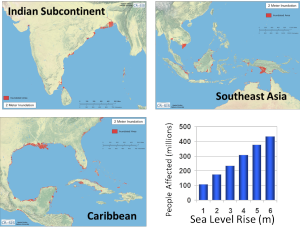Sea Level Rise
One of the most threatening aspects of climate change — sea level rise — is also perhaps the most difficult to predict. We simply don’t know yet how far or how fast sea level will rise.
So far thermal expansion has accounted for most of sea level rise — 10 to 20 cm (4-8 inches) in the past century. “Thermal expansion” is simply the increase in volume of water as it warms (warm water takes up more volume than cold water). So as the temperature of the water rises, the water expands and sea level rises. But melting of the ice sheets on Greenland and Antarctica are increasing their contribution to sea level rise. As reported by Briggs et al., 2016, “…the Antarctic and Greenland Ice Sheets contributed 3.7 and 7.4 millimeters to global sea levels, respectively, between 1992 and 2011, and — alarmingly — the combined contribution rose from about 10% to 30% of the global sea level trend over the same period (Beckley et al., 2010).”
Sea Level Rise is Accelerating
Taking into account all factors causing sea level rise, Jevrejeva et al., 2014 estimated that there is a 95% probability that sea level rise will be a maximum 1.9 meters (6.2 feet) by 2100. They caution however, that the possibility exists that the sea level rise will be more if we see acceleration of ice loss in the Western Antarctic Ice Sheet, which in fact is happening.
Evidence of just such an acceleration was published by Rignot et al., 2014 who showed that enormous glaciers in the Amundsen Sea area of Western Antarctica had come ungrounded and are virtually “unstoppable”. The Jevrejeva et al estimate was widely published, but prudent government institutions are now looking at the possibility of 3 meters (~10 feet) by 2100.
Even a small rise can be devastating though. Witness the storm surge with Hurricane Sandy, flooding the Manhatten subways. The US Federal Emergency Management Agency (FEMA) predicts that a 32 cm (1 ft) rise by 2050 would cause 40-60% more damage than at current sea levels. A 2 meter sea level rise would affect about 180 million people, many in the US. That’s just 2 meters, about 7 feet. And it’s possible in the next 100 years, or before.
Maps showing areas affected by a 2 meter sea level rise are from Center for Remote Sensing of Ice Sheets (CReSIS). Additional data are from Rignot et al., 2011 and from Steffen and Huff, 2005, Univ of Colorado, Boulder.
Throughout all of human civilization, sea level has remained relatively unchanged. We have built our cities, our infrastructure, and much of our cultural treasures near sea level. The dollar value of moving all of that is staggering.
Sea level rise is a complex problem, but we are understanding more and more about sea level rise timing and magnitude and will be much better able to predict what we must do — and by when — in the next decades.
See also Glaciers and Sea Ice are Melting.
Last update Nov 30, 2017
